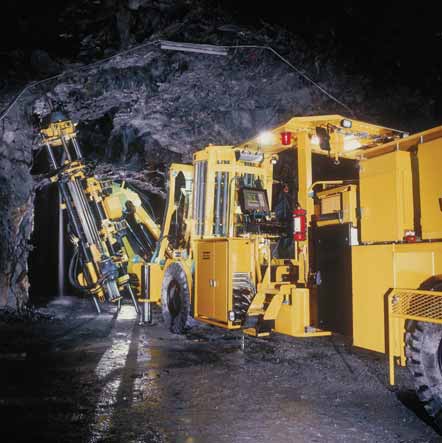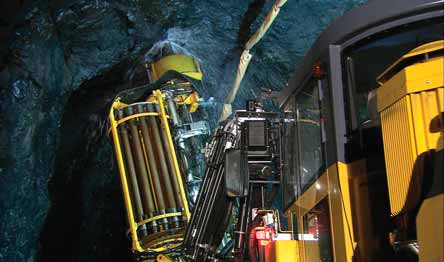
LKAB has been using Wassara water drill-equipped Atlas Copco Simba W469 rigs, as shown
above, since 1995 in its Kiruna and Malmberget mines to sink holes up to 55 m long.
LKAB Stays with Water Power for Production Drilling

Super Sublevels, Wassara Hammers
LKAB’s predilection for water-powered
drills dates from the 1980s, when reducing
employment levels was a major element of
the company’s business strategy; and links
to the preferred mining method at both
mines—sublevel caving. Recognizing that
increasing the slice height between sublevels
would reduce costs as long as dilution
could be carefully controlled, the
Mining R&D team studied the options for
drilling longer holes. The conventional
Norwegian AMV DTH production drilling
rigs in use could drill accurately. The top
hammer machines could drill quickly and
with reasonable accuracy, especially when
used with tubes, but LKAB believed the
water-powered DTH hammer concept proposed
by G-Drill had the potential to
improve on the speed of conventional DTH
and on the accuracy of the top hammer rigs
in use at that time.
G-Drill, LKAB and the Swedish Board of Development joined forces in 1988 and the resultant patented Wassara works at roughly twice the frequency rate of conventional pneumatic DTH hammers. The drill has a unique stabilized piston case that enables straight drilling with superior precision. Field testing of prototype drills on an AMV production rig suitably modified by AMV’s local dealer commenced in 1990 and the benefits of the technology were subsequently proven in more than 100,000 m of drilling, achieving an approximate 40% increase in productivity.
Within the scope of the major project to move the haulage level at Kiruna down to the 1,045 m level, LKAB issued a tender in 1993 specifying an automated production drilling rig able to use the Wassara to drill 115-mm holes of up to 55 m in length. Atlas Copco was the successful bidder, offering a machine based on the Simba production rigs already in use by LKAB. It was equipped for remote control from surface and designed to drill 10-hole fans automatically. Deliveries of this Simba W469 machine started in 1995 and LKAB now has 10 units split between Kiruna and Malmberget that carry out a large proportion of the mines’ production drilling. In 2006, Atlas Copco started delivery of three updated Wassara-equipped drilling rigs based on the Simba L6C and designated W6 (E&MJ, October 2006, p 44). LKAB needs these to achieve planned production rates prior to the availability of the new Sandvik machines.
Meanwhile LKAB had early on acquired G-Drill AB, the originator of the Wassara technology, and retained the staff. In the mid-1990s, the mining company sold 40% of the company to Sandvik Tamrock and the joint venture partners developed a complete drilling system, comprising the patented Wassara hammer, drill bits, drill tubes, check valves, swivels and highpressure pump. The company was renamed Wassara AB in 2002. Recently, LKAB approved another new level development at Kiruna and in parallel drew up the new longer-hole automated rig specification that Sandvik is developing. Subsequently, in late 2006, LKAB opted to buy Sandvik’s interest in Wassara and now wholly owns the Stockholm-based company, which presently has sales of about SEK35 million ($5.1 million).
LKAB will develop a new strategy for the company and assess the possibilities for a major increase in sales within a fiveyear period but own use is still a key factor. Jan-Erik Jatko, who is chairman of Wassara and vice president of Special Businesses for LKAB, said: “Wassara’s water-hammer is a valuable asset for us in the continued vertical expansion of both Kiruna and Malmberget. We believe in this technology which, in comparison with top hammer technology, results in faster, straighter drilling and environmental advantages.” Dan Gustafsson, president of Wassara AB, added that the new ownership will not affect collaboration with Sandvik on products for LKAB and the wider market.

“Even more rigorous demands are being made of hole straightness,” said Jan-Olov Nilsson, who has been involved with LKAB’s drilling technology development throughout the adoption of the water-powered drilling technique. “Given the hole straightness requirement, the only drilling method that qualifies for consideration is water-powered DTH drilling, and that with the Wassara hammer. Although Sandvik no longer has a stake in Wassara AB, part of the LKAB agreement with the manufacturer includes developing the Wassara concept as much as possible,” he continued.
“Long-hole drilling is one of the most important processes for LKAB and we have been issued with strict requirements by the customer,” said Elias Engman, Sandvik’s account manager for LKAB. “The carriers subject to the agreement are based on previously established designs and the hammer technology is also familiar to us. The element that will now be specially developed is a control system to meet LKAB’s automation requirements,” Engman explained.
The new machines will have complete fan automatics, be remote controlled and monitored from a control room in the mine. Each fan will involve between 300 and 600 m of uphole drilling, with individual holes of up to 60 m in length, an increase of about 5 m over current practice. The rigs will only be manned when moving to a new fan drilling position. “We have rock that is relatively tough on drill bits, particularly at Malmberget where they average approximately 70–80 m between regrinds,” said Nilsson. The rigs will feature a separate magazine for the hammers mounted with new or ground bits. The hammers can be automatically replaced on the basis of a pre-set value for meters drilled. The magazine will hold eight hammers.